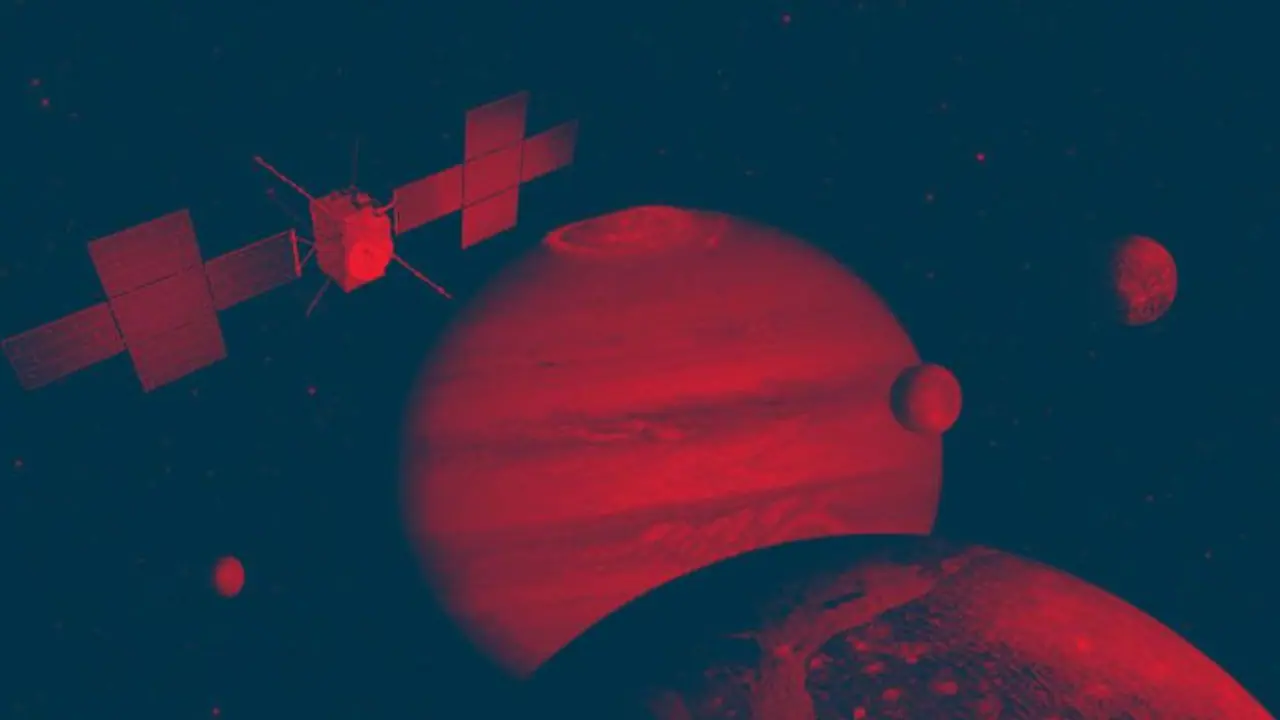The Mission aims at studying all three moons, but special attention will be given to Ganymede -- the biggest moon in our solar system, surpassing the sizes of Pluto and Mercury, and the sole moon that has the ability to produce its own magnetic field, says Girish Linganna
The European Space Agency (ESA) is scheduled to launch the Jupiter Icy Moons Explorer (JUICE) Mission, using an Ariane 5 launcher -- and utilizing Earth and Venus gravity assists -- from its spaceport in Kourou, French Guiana at 12.15 UTC (5:45 pm IST).

The JUICE spacecraft will set off on an eight-year-long voyage and will reach Jupiter in 2031. The satellite will conduct a thorough investigation and its objective is to explore three of Jupiter’s Galilean moons -- namely Ganymede, Europa and Callisto.
A group of companies, headed by Airbus Defence and Space, which is accountable for the Airbus group’s defence and space-related products, has created Juice according to ESA guidelines.
Jupiter has been explored by only two other spacecraft -- the Galileo probe, which orbited the planet from 1995 to 2003, and Juno, which has been in orbit around Jupiter since 2016. However, when Juice reaches Jupiter, NASA’s Europa Clipper will already be studying the planet. The Europa Clipper is set to launch in October this year and is expected to arrive at Jupiter in 2030 to specifically study the Europa moon.
The Mission aims at studying all three moons, but special attention will be given to Ganymede—the biggest moon in our solar system, surpassing the sizes of Pluto and Mercury, and the sole moon that has the ability to produce its own magnetic field. The Juice satellite will carry a total of 10 sophisticated instruments, including the most powerful remote-sensing, geophysical and in situ payload devices ever flown to the outer solar system beyond Mars.
Some of these instruments include:
3GM (Gravity & Geophysics of Jupiter and Galilean Moons): A radio package comprising the Ka transponder (KaT), Ultrastable Oscillator (USO) and High Accuracy Accelerometer (HAA). The experiment will study the gravity field at Ganymede, the extent of the internal oceans on the icy moonsand the structure of the neutral atmosphere and ionosphere of Jupiter and its moons.
GALA (GAnymede Laser Altimeter): It will study the tidal deformation of Ganymede and the topography of the surfaces of the icy moons.
JANUS: An optical camera system that will study global, regional and local features and processes on the moon, besides mapping the Jupiter’s clouds. It will have a spatial resolution of up to 2.4 m on Ganymede and about 10 km at Jupiter.
J-MAG (The JUICE magnetometer): It is equipped with sensors to characterize the Jovian magnetic field and its interaction with that of Ganymede and to study the sub-surface oceans of the icy moons.
MAJIS (Moons and Jupiter Imaging Spectrometer): It will observe cloud features and atmospheric constituents on Jupiter and will characterize ices and minerals on the icy moon surfaces.
PEP (Particle Environment Package): It comprises a package of sensors to characterize the plasma environment of the Jupiter system.
RIME (Radar for Icy Moon Exploration): Ice-penetrating radar to study the sub-surface structure of the icy moons down to a depth of around 9 km.
RPWI (Radio and Plasma Wave Investigation): It will characterize the radio emission and plasma environment of Jupiter and its icy moons using a suite of sensors and probes.
SWI (Sub-millimeter Wave Instrument): Will investigate the temperature structure, composition and dynamics of Jupiter’s atmosphere and the exospheres and surfaces of the icy moons.
UVS (UV Imaging Spectrograph): It will characterize the composition and dynamics of the exospheres of the icy moons, to study the Jovian aurorae and to investigate the composition and structure of the planet’s upper atmosphere.
NASA will also provide some sub-systems for two additional instruments:
* The Particle Environment Package (PEP)
* Radar for Icy Moon Exploration (RIME) experiment
NASA will also provide an Ultraviolet Spectrograph (UVS) for its Juice mission.
Juice does not have the ability to identify the existence of life. Its main function is to determine if there are any potential locations within the icy moons of Jupiter that possess the necessary components for supporting life, including water, essential biological elements, energy & stability
Adam Masters, a senior lecturer, a senior lecturer in space and atmospheric physics at Imperial College, London, and a member of the team responsible for building one of the scientific tools for Juice, stated in an interview with Space.com that, if there is life on these moons, it is most likely in the water, which is difficult to reach. This is because it is not currently feasible to penetrate deeply beneath the ice cover, where life could be found.
The author of this article is a Defence and Aerospace analyst
